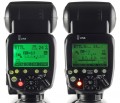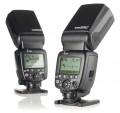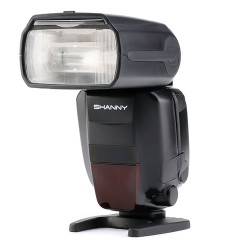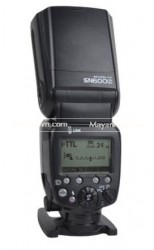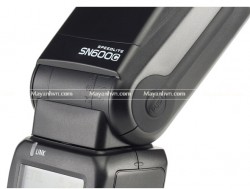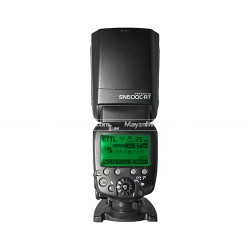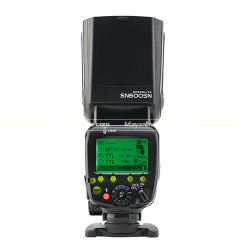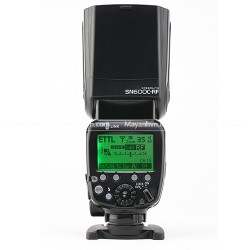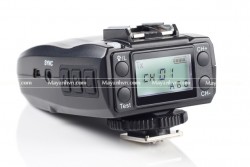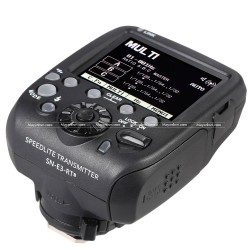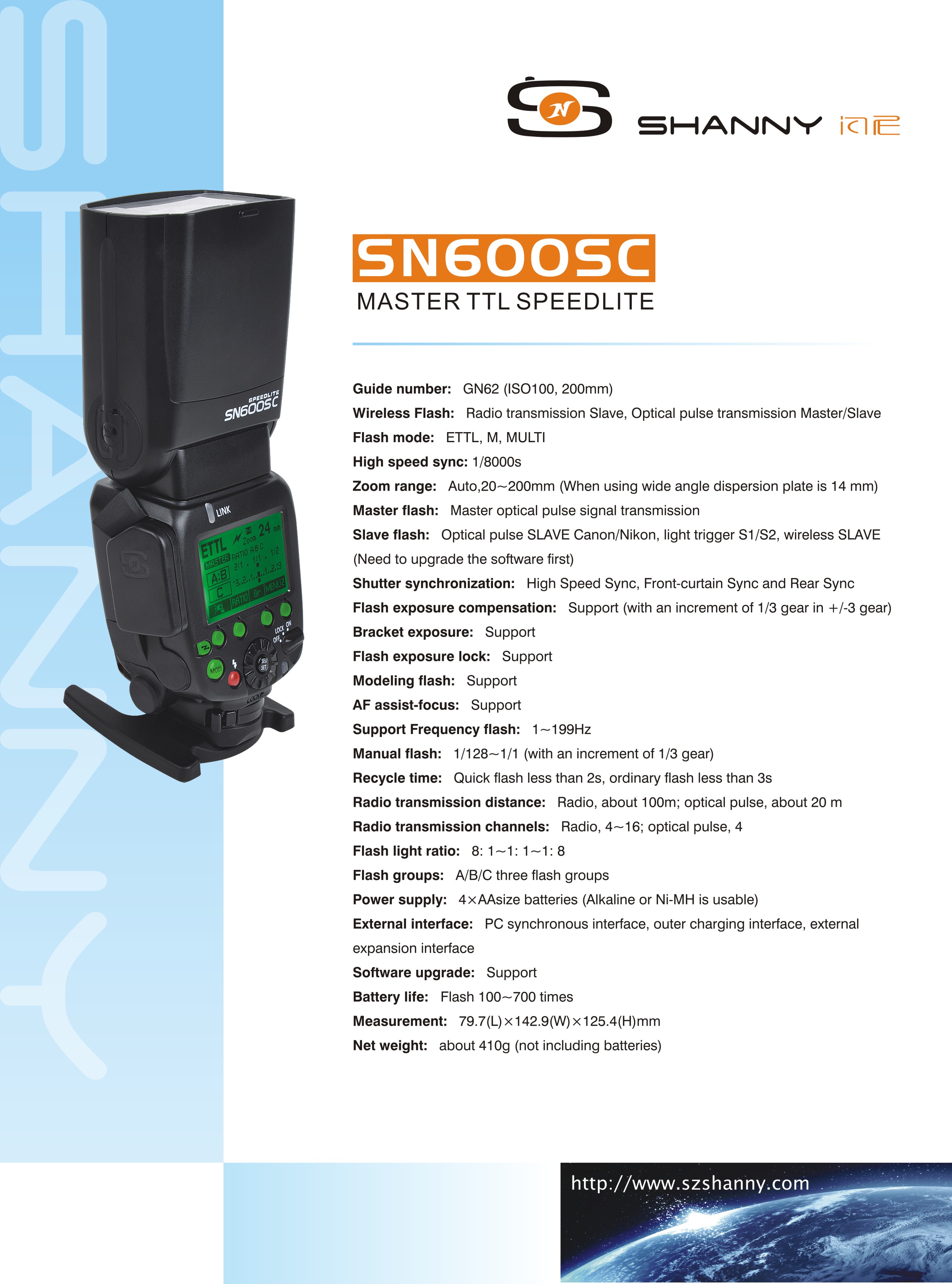

The SN600SC do not actually come with any built in radio function (keeping the price low), though with the addition of a clip on external radio receiver, their function is then transformed into a Canon RT compatible radio slave flash.
This provides a very economical flash option for the many current YongNuo YN-622C TTL radio trigger owners, while still leaving the option open for upgrading or transitioning to the more recent Canon RT radio system later.
YongNuo have their own YN600EX-RT flash to be released soon as well (and Shanny have a similar model coming very soon too). Though the YN600EX-RT are likely to be priced closer to $200, where as the SN600SC are from around just $100.
And Shanny also have even lower priced (from around $70), full HSS, TTL, and YN-622C compatible flash model variations coming as well (SN600C & SN600N).

Of course these are all great options for the many people just after an on-camera HSS TTL flash as well, and at less than a quarter of the Canon 600EX-RT price.
If the SN600SC flashes are any indication though, its clear that Shanny are very capable. And YongNuo now have some serious competition on their hands, on all fronts, and before the YN600EX-RT are even available.

SN600SC Features
- Full Power – GN 62m (ISO 100 / 200mm)
- HSS to 1/8000th
- Flash Mode – ETTL /M / Multi
- 1st Curtain Sync / 2nd Curtain Sync
- FEC / FEB - 1/3rd Increments (±3 stops)
- Manual Flash – 1/128 – 1/1 output control (1/3rd increments)
- 24-200mm Auto and Manual Flash Zoom
- Canon RT / Shanny Radio Slave Mode (with clip on SN-E3-MD receiver)
- Master and Slave Modes for Canon Optic Wireless system
- Slave Mode for Nikon Optic Wireless system
- S1 & S2 Basic Optic Slave Modes
- Full power recycle – from 1.8 seconds
- Supports Multiple Flash Groups
- Radio Channels – 4 to 16
- Optic Channels – 4
- Supports Canon Flash Control Menus
- Custom Functions
- Sound Prompt
- Heat Protection
- LCD Back Light Can be Kept On
- Crop Sensor Auto Zoom Option
- AF Assist Light
- Full 360 Degree Swivel and Tilt Head (With Tilt Lock Button)
- Large Clear Dot Matrix LCD Screen
- Canon Like Interface
- Fast Clamping Metal Foot with Locking Pin (And Clamps Well)
- Good Build Quality
- External Battery Port
- PC Sync Port
- 2.5mm Communication Port (for radio receiver)
- No USB Port, Though Firmware Updates May be Possible Through Radio Receiver USB Port.
Limitations
- No RT Radio Master Mode Possible
- RT Radio Slave Mode Requires an External Receiver Unit
- AF Assist Light is Good, But Not Great
- No Compatibility with Phottix Odin or Pixel King Pro (YN-622C work well)

Overview
The new SN600SC (without the external radio receiver attached) basically provide the functions of a Canon 580EX II, though wrapped in a later body almost identical to the current Canon 600EX-RT Speedlite. The SN600SC provide Canon Optic Wireless Master and Slave modes, as well as a Nikon Optic Wireless Slave mode option.
With the addition of a small clip on Shanny SN-E3-MD radio receiver module, the SN600SC are also transformed into a Canon RT compatible radio slave flash (no radio master mode though).
The SN600SC also appear to be functioning very well with the YongNuo YN-622C / YN-622C-TX. Which will likely see the SN600SC as a desirable option for people looking for a full HSS TTL flash to use with their existing YN-622C system. While then still having the option of transitioning to the RT radio system later, should that become preferable (as may well be the case, with Shanny making improvements to the RT system).
Build Quality
The build quality and function of the SN600SC (and all similar Shanny flashes) appears surprisingly good. The case is almost identical to the Canon 600EX-RT, though you can see the plastic is a little bit less refined, and the buttons possibly a little harder to press etc. The main giveaway is likely the Shanny LCD screen is not as high a resolution, though its still easy to mix this flash up with the original Canon 600EX-RT without realizing.
Secure Clamping Foot
One of the things I find most significant though, is that the Shanny level lock clamping foot actually clamps tightly in the camera hotshoe, and does not allow the flash to slop around any more than the original Canon flash does.
The contact pins are also very pointed like the Canon pins, helping to reduce the possibility of any dust or oil preventing connection with the camera hotshoe contacts.
These are significant things when it comes to reliability, and this is exactly where YongNuo and Pixel struggle. The lever lock on the YongNuo YN-E3-RT transmitter, and Pixel Mago flash, both have quite loose clamping feet, and I wouldn’t be surprised at all if the much awaited YongNuo YN-600EX-RT will have the same issue as well.
So its impressive Shanny have come straight out of the gates with a decent solid mount, especially considering some of these flashes will literally be priced from around $70. Phottix have also done a good job at this with the Mitros / +, though they are $300+ flashes.

Tilt Lock
Another feature many third party flashes have been leaving out is a locking button for the flash tilt and swivel. Shanny have added a lock for the tilt motion only. And like the Canon 600EX-RT, this only locks into place when the flash head is pointed straight up, or faced directly forward.
I really don’t know if this is will end up being a good feature or not, as sometimes it is better to keep things like this simple so they can’t go wrong down the track. The locking button appears to work fairy well, though it does require more concentration to press the button in, disengaging the lock, than with the 600EX-RT.
Being for the tilt motion only, this lock doesn’t remove any stress on the flash foot when swiveling the flash head, as the 600EX-RT lock does. Nevertheless some people do find this feature important when mounting heavy modifiers like the original Lightsphere’s etc.

TTL Exposures
I have a couple of the Shanny flash models here, and the SN600SC is a actually a pre-production version. The TTL exposures are very good and consistent already though (better than a number of production flashes that have been released recently).
There were a few small quirks, like the TTL exposures changing with increased camera ISO settings, though Shanny have assure these issues have already been fixed with production versions available now.
Otherwise the SN600SC (and similar Shanny flashes) are very impressive for the remarkably low price compared to the Canon 600EX-RT. The power can really match the Canon flash, and recycle is considerably faster. HSS provides more light than the 600EX-RT flash, and the SN600SC even outperformed the 600EX-RT in shots before heat protection cut in.
USB Port ?
One slight possible concern with the SN600SC may be the lack of any direct USB port for firmware updates. Though the optional clip on SN-E3-MD radio receiver does have a USB port for firmware updates. And Shanny appear to be indicating this port and radio module can then be used as a flash firmware update module as well. This may not be 100% confirmed until a flash firmware update is actually needed and implemented though.
Although the YongNuo YN-622C TTL triggers work very well with the SN600SC, there is basically no compatibility with the Phottix Odin or Pixel King Pro.

Interface
The SN600SC (and other Shanny flash models) have an interface and LCD screen display very similar to the original Canon 600EX-RT. Quite noticeable though is the lower resolution of the Shanny screen, making the characters appear a little more pixelated.
The SN600SC do not display a distance scale like the 600EX-RT does though, so this leaves room for the rest of the details to be displayed larger on the Shanny LCD. The SN600SC also do not display the cameras aperture setting either, a camera symbol (lower left of the LCD screen) simply shows when the flash is in sync with the cameras settings.
The SN600SC’s LCD screen is also brighter than the Canon 600EX-RT’s default setting as shown below (or the brightest setting either).

Up closer its easier to see the pixelated display. This is still very clear and easy to understand though.
Controls are very similar to the 600EX-RT. The Shanny buttons may be slightly harder to press, otherwise they are quite similar.

Mode
The main Mode button simply scrolls through ETT, M (Manual), and MULTI modes.
Unlike the 600EX-RT the SN600SC does not have the Ext.A mode (or an auto metering sensor on the front of the flash).

Wireless Button
The Wireless Button scrolls though the Canon Optic Wireless Master and Slave modes, Nikon Optic Wireless Slave mode, and the basic S1 and S2 optic slave modes.
S1 is a regular optic slave, which fires the flash from the light of any other flash. And S2 ignores pre-flashes, so a TTL flash can be used to optically trigger the SN600SC in sync as well. (S1 and S2 can only work with manual power settings).

FEC (Flash Exposure Compensation)
FEC can be set directly on the flash with +3 or -3 stops of adjustment. Or via the cameras FEC adjustment.
Like the 600EX-RT, making an FEC setting on the flash overrides the cameras FEC setting.
And only FEC settings made directly on the flash are displayed as a number (+0.7 etc). FEC settings made on the camera are only shown via the scale and FEC symbol.

Custom Functions
8 custom functions are accessible directly through the flash interface -
- 01 – Auto Power Off
- 03 – FEB Auto Cancel
- 04 – FEB Sequence
- 08 – AF Assist Beam Firing
- 09 – Auto Zoom for Sensor Size
- 10 – Slave Auto Power Off Timer
- 20 – Sound ON / OFF
- 22 – LCD Light – 12 seconds / ON / OFF
And 2 more custom functions are accessible through the Canon External Flash Custom Functions Menu -
- 02 - Modelling Flash Options
- 06 - Quick Flash with Continuous Shot
A couple of these custom functions which are often absent on similar third party flashes, and appreciated with the SN600SC, are the option to leave the LCD back light on all the time, and Auto Zoom for Sensor size when using APSC crop sensor cameras.

Unfortunately No.12 – Flash Recycle With External Power, is still not available with the SN600SC. That is the option to have the flash capacitor powered by an external battery pack only, saving the batteries inside the flash to run for long periods.
Battery Level Indicator
The SN600SC only show a battery level indicator symbol when the battery is running low.

Flash Power
As seen in the light pattern images bellow, it can be a little difficult to accurately measure and compare flash power between different speedlites, as the light patterns are not always even.
The SN600SC (and similar Shanny flashes) are still quite clearly matching the Canon 600EX-RT for light output though. Bouncing or diffusing the flashes in direct comparisons, the light meter readings are virtually even all the way around.
So the Shanny flashes can really match the Canon 600EX-RT for power, where many other third party flashes like the YN-568EX II etc are at least 2 or 3 tenths bellow.

Light Pattern
Below is a direct comparison of the light patters produced by the SN600SC and the Canon 600EX-RT at each flash zoom length.
These are all shot at the same 17mm lens zoom length (on a Canon 7D), so that the full light patterns can be seen.
The SN600SC results are quite good, and closer to the Canon 600EX-RT than many other third party flashes.
(These are all shot at 5500K, so this also provides some idea of the color difference between the 2 flashes as well).

And below are some tests showing the flash zoom matched to a full frame camera lense zoom.


Manual Power Levels
Accuracy between the SN600SC manual power levels are very good, all within 1 tenth of a stop between levels.
Even the Canon flash shows some variation here, with 1.3 stops between 1/2 and full power.
These results were recorded with the flashes mounted in a softbox to avoid any hot spots, and in exactly the same position and settings etc. The SN600SC equals or betters the 600EX-RT output at any power level.
| |
SHANNY SN600SC |
|
CANON 600EX-RT |
|
| |
|
Diff. EV |
|
Diff. EV |
| 1/1 |
F 16 |
|
|
F 16 |
|
|
| |
|
|
0.9 |
|
|
1.3 |
| 1/2 |
F 11 |
+ 0.1 |
|
F 8 |
+ 0.7 |
|
| |
|
|
1.0 |
|
|
1.0 |
| 1/4 |
F 8 |
+ 0.1 |
|
F 5.6 |
+ 0.7 |
|
| |
|
|
0.9 |
|
|
1.0 |
| 1/8 |
F 5.6 |
+ 0.2 |
|
F 4 |
+ 0.7 |
|
| |
|
|
1.1 |
|
|
0.8 |
| 1/16 |
F 4 |
+ 0.1 |
|
F 2.8 |
+ 0.9 |
|
| |
|
|
1.0 |
|
|
0.9 |
| 1/32 |
F 2.8 |
+ 0.1 |
|
F 2.8 |
|
|
| |
|
|
0.9 |
|
|
1.1 |
| 1/64 |
F 2 |
+ 0.2 |
|
F 1.4 |
+ 0.9 |
|
| |
|
|
1.1 |
|
|
0.9 |
| 1/128 |
F 1.4 |
+ 0.1 |
|
F 1.4 |
|
|
| . |
|
|

ETTL Exposures
The SN600SC ETTL exposures appear to be very promising. The original flash tested here is a pre-production model, though already the exposures have been consistent.
There are no issues noted at different zoom lengths, or metering modes etc, as other flashes have suffered from recently.
There were a few issues discovered though, like flash exposures changing with ISO setting, and one FEC graduation being out from what it should be, though Shanny have assured the production versions available now have fixed any noted issues.

Recycle Time
The SN600SC’s full power recycle time is from around 1.8 seconds using a good set of Eneloop batteries. Compared to the Canon 600EX-RT at around 2.6 seconds with the same batteries.
This is quite an impressive difference as the Shanny flashes really are matching Canon for light output. So Shanny are not fudging anything or dialing down the light to achieve these faster recycle times.
And the SN600SC have a High Voltage Port for external battery packs, if faster recycle times are needed.

Overheat Protection
The SN600SC user manual states that after 20 shots the flash recycle will be slowed to protect the flash from overheat damage.
Though in practice, when compared directly with the Canon 600EX-RT, I found the SN600SC would outperform Canon’s aprox 47 full power shot limit before shutting down the flash in overheat protection mode.
The SN600SC’s full recycle time indicator does slow well before the full shutdown. Though the flash would still fire on the early quickflash ready indicator, and this showed no loss in light compared to waiting for the full recycle indicator. So in practice this still produces more shots than the 600EX-RT.
After 50 or 60 shots the flash will shut down though to cool for 10 minutes or so.

Flash Duration
There is nothing particularly notable about the SN600SC’s flash durations. Most speedlites, being IGBT flashes, have a fairly long flash duration at full power, and increasingly very short durations at lower power levels.
Due to the long duration at full power, most speedlites lose around 3/10ths of a stop of light from around 1/160th shutter speed moving up to a 1/250th maximum x-sync speed. The Canon 600EX-RT results are shown below, and the SN600SC are results are quite similar to this.


Color & Consistency
As seen in the flash pattern images further above, the SN600SC have a slightly cooler colour temperature than the Canon 600EX-RT.
There is also very little colour change at different power levels, as speedlites generally do not suffer much from colour shift issues at different power levels.

AF Assist Light
Shanny have implemented their own unique AF assist light pattern. This is a single AF light for all focus points, unlike the Canon 600EX-RT, which use a more sophisticated second light pattern when outer AF points are selected.
The Shanny AF light is probably a little better than the recent AF lights found in the YN-622C-TX (and likely current YongNuo flash models), in that there is not quite as much gap in the light pattern for a focus point to fall completely between any pattern.
These samples where taken at 1.8m (or 6 feet) from the subject, and at the zoom lengths as noted.

For on-camera flash use, practicality of the AF assist light is likely one of the biggest differentiating features between the less expensive third party flash options, and the Canon and Nikon etc flashes.
These AF lights are slowly becoming more refined and practical though, and the recent YongNuo and Shanny lights are generally still quite reasonable now. Though Canon do still have a good advantage here at this stage.

Ports
Following the Canon 600EX-RT design, the SN600SC (and similar Shanny models) all provide a screw lock PC sync port, and a high voltage external Battery port.
The third socket shown to the right, is a threaded mounting point for the Canon SB-E2 reporter style flash brackets. This is a fine thread, not a regular 1/4″ 20 thread for attaching to umbrella swivels etc.
Just out of the top right of the frame is also a 2.5mm mini-phone style socket. The SN600SC use this is a communication port for attaching an external Shanny radio receiver, and not a wireless shutter release port as the 600EX-RT provides.


Battery Compartment
Again Shanny have closely followed Canon’s design with the battery compartment and door. The door has the same sliding release button, and even a rubber weather seal like the Canon flash.
The batteries follow the same Canon format as well, and this all helps for people used to using the 600EX-RT already, or using both flashes together.


Other Third party TTL Radio Trigger Compatibility
YongNuo YN-622C - The SN600SC appear to be very compatible with the YongNuo YN-622C and YN-622C-TX.
Some quirks may be discovered with more and different use, though I have checked most of the issues previously noted with other flashes, and haven’t seen same problems with the SN600SC.
Please note though – although I doubt this compatibility is a coincidence, Shanny do have their own radio trigger system for the SN600SC (detailed further down), and they have not made any claims of third party compatibility themselves at this stage, and are not really obligated to provide any.
Nevertheless, the SN600SC are so far looking to be a great economical flash option used with the current YN-622C, while still providing the option of later upgrading to the Canon RT radio system (via an additional Shanny SN-E3-MD radio receiver module).

Phottix Odin - Have no compatibility with the SN600SC at all (Odin receivers will not even fire them).
Pixel King Pro – Only fire the SN600SC at the manual power setting set on the flash (even in TTL mode). No other functions or remote control.

Shanny / Canon RT Radio Trigger Compatibility
A very unique feature of the SN600SC is the ability of the flash to be upgraded to a Canon RT compatible radio slave flash.
Plugging an additional Shanny SN-E3-MD radio receiver module into the mini-phone port on side of the flash, will then provide wireless radio compatibility with Canon’s own ST-E3-RT transmitter, or a Canon 600EX-RT flash as radio master.
And Shanny have their own ST-E3-RT style radio transmitter to be available very soon as well, which will likely add new functions to the Canon RT system.
As well as a Shanny SN600EX flash coming which will have radio transceivers built inside, and provide RT master and slave modes like the original Canon 600EX-RT. (The current SN600SC provides a more economical RT slave only option).

The Shanny SN-E3-MD radio receiver modules also have a USB port in the base for firmware updates.
And Shanny appear to be indicating this port and radio module can then be used as a flash firmware update module as well.
SN-E3-RT
The Shanny SN-E3-RT transmitter unit should also be available very soon.
At this stage we know the SN-E3-RT will provide extra functions over the Canon ST-E3-RT, including Canon Optic Wireless transmission as well as the 2.4GHz Canon RT radio transmission. And an AF assist light.
The SN-E3-RT also provided a unique high-resolution TFT color screen, where you can even select your own font and background colours. As well as being dimmable. A USB port for firmware updates is also provided.



SN600S Slave Flash
And this is probably an appropriate time to mention the other of Shanny’s first two flash models available, as the SN600S are the other Shanny flash model also compatible with the SN-E3-MD radio receiver module mentioned above.
Click to Expand

Accessories
As with most current speedlites, the SN600SC come with a plastic base stand, and a padded case. No diffuser cap is provided, though Canon 600EX-RT size accessories will fit the Shanny flash head.
Again Shanny have provided that little bit extra, with the padded flash case having a strong velcro belt loop on the back (though I don’t know how practical the orientation is).
And even the boxes the Shanny flashes come in are a nice solid box, with a solid lid that slides off the top. So these are actually practical boxes to keep using with the flashes.

The included Shanny user manuals are nothing flashy, though they are quite easy to understand in English compared to Pixel or YongNuo manuals etc.
SN600SC - User Manual
- See more at: http://flashhavoc.com/shanny-sn600sc-speedlite-review/#sthash.aYOJn9rK.dpuf
 0 đánh giá
0 đánh giá


